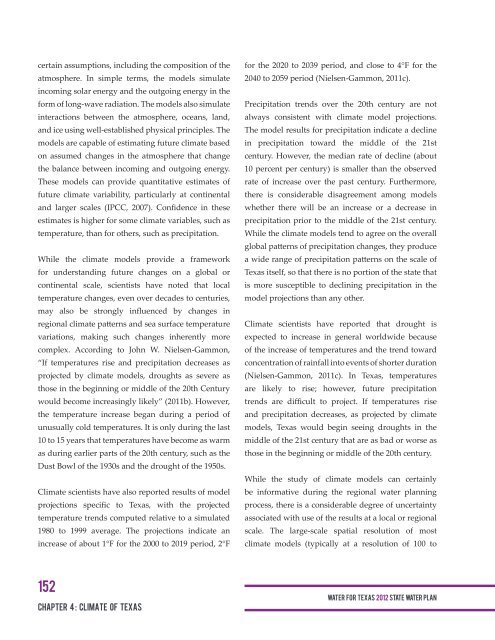Chapter 4 Climate of Texas - Texas Water Development Board
Chapter 4 Climate of Texas - Texas Water Development Board
Chapter 4 Climate of Texas - Texas Water Development Board
Create successful ePaper yourself
Turn your PDF publications into a flip-book with our unique Google optimized e-Paper software.
certain assumptions, including the composition <strong>of</strong> the<br />
atmosphere. In simple terms, the models simulate<br />
incoming solar energy and the outgoing energy in the<br />
form <strong>of</strong> long-wave radiation. The models also simulate<br />
interactions between the atmosphere, oceans, land,<br />
and ice using well-established physical principles. The<br />
models are capable <strong>of</strong> estimating future climate based<br />
on assumed changes in the atmosphere that change<br />
the balance between incoming and outgoing energy.<br />
These models can provide quantitative estimates <strong>of</strong><br />
future climate variability, particularly at continental<br />
and larger scales (IPCC, 2007). Confidence in these<br />
estimates is higher for some climate variables, such as<br />
temperature, than for others, such as precipitation.<br />
While the climate models provide a framework<br />
for understanding future changes on a global or<br />
continental scale, scientists have noted that local<br />
temperature changes, even over decades to centuries,<br />
may also be strongly influenced by changes in<br />
regional climate patterns and sea surface temperature<br />
variations, making such changes inherently more<br />
complex. According to John W. Nielsen-Gammon,<br />
“If temperatures rise and precipitation decreases as<br />
projected by climate models, droughts as severe as<br />
those in the beginning or middle <strong>of</strong> the 20th Century<br />
would become increasingly likely” (2011b). However,<br />
the temperature increase began during a period <strong>of</strong><br />
unusually cold temperatures. It is only during the last<br />
10 to 15 years that temperatures have become as warm<br />
as during earlier parts <strong>of</strong> the 20th century, such as the<br />
Dust Bowl <strong>of</strong> the 1930s and the drought <strong>of</strong> the 1950s.<br />
<strong>Climate</strong> scientists have also reported results <strong>of</strong> model<br />
projections specific to <strong>Texas</strong>, with the projected<br />
temperature trends computed relative to a simulated<br />
1980 to 1999 average. The projections indicate an<br />
increase <strong>of</strong> about 1°F for the 2000 to 2019 period, 2°F<br />
for the 2020 to 2039 period, and close to 4°F for the<br />
2040 to 2059 period (Nielsen-Gammon, 2011c).<br />
Precipitation trends over the 20th century are not<br />
always consistent with climate model projections.<br />
The model results for precipitation indicate a decline<br />
in precipitation toward the middle <strong>of</strong> the 21st<br />
century. However, the median rate <strong>of</strong> decline (about<br />
10 percent per century) is smaller than the observed<br />
rate <strong>of</strong> increase over the past century. Furthermore,<br />
there is considerable disagreement among models<br />
whether there will be an increase or a decrease in<br />
precipitation prior to the middle <strong>of</strong> the 21st century.<br />
While the climate models tend to agree on the overall<br />
global patterns <strong>of</strong> precipitation changes, they produce<br />
a wide range <strong>of</strong> precipitation patterns on the scale <strong>of</strong><br />
<strong>Texas</strong> itself, so that there is no portion <strong>of</strong> the state that<br />
is more susceptible to declining precipitation in the<br />
model projections than any other.<br />
<strong>Climate</strong> scientists have reported that drought is<br />
expected to increase in general worldwide because<br />
<strong>of</strong> the increase <strong>of</strong> temperatures and the trend toward<br />
concentration <strong>of</strong> rainfall into events <strong>of</strong> shorter duration<br />
(Nielsen-Gammon, 2011c). In <strong>Texas</strong>, temperatures<br />
are likely to rise; however, future precipitation<br />
trends are difficult to project. If temperatures rise<br />
and precipitation decreases, as projected by climate<br />
models, <strong>Texas</strong> would begin seeing droughts in the<br />
middle <strong>of</strong> the 21st century that are as bad or worse as<br />
those in the beginning or middle <strong>of</strong> the 20th century.<br />
While the study <strong>of</strong> climate models can certainly<br />
be informative during the regional water planning<br />
process, there is a considerable degree <strong>of</strong> uncertainty<br />
associated with use <strong>of</strong> the results at a local or regional<br />
scale. The large-scale spatial resolution <strong>of</strong> most<br />
climate models (typically at a resolution <strong>of</strong> 100 to<br />
152<br />
<strong>Chapter</strong> 4 : climate <strong>of</strong> <strong>Texas</strong><br />
WAT E R FOR TEXAS 2012 STATE WATER PLAN
















